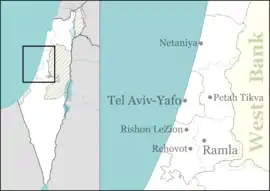Kfar Chabad
Kfar Chabad (Hebrew: כְּפַר חַבָּ"ד, lit. "Chabad Village") is a Chabad-Lubavitch village in central Israel. Between Beit Dagan and Lod, it falls under the jurisdiction of Sdot Dan Regional Council.[2] In 2019 it had a population of 6,598.[1]
Kfar Chabad
כפר חב"ד كفار حباد | |
|---|---|
| Hebrew transcription(s) | |
| • official | Kfar Habad, Kefar Habad |
 Full-scale replica of "770" in Kfar Chabad | |
 Kfar Chabad | |
| Coordinates: 31°59′19″N 34°51′7″E | |
| Country | Israel |
| District | Central |
| Council | Sdot Dan |
| Affiliation | Chabad |
| Founded | 1949 |
| Population (2019)[1] | 6,598 |
History
Kfar Chabad was established in 1949 by Yosef Yitzchak Schneersohn.[3] The site had previously been the depopulated Palestinian village of al-Safiriyya (known to the Byzantines and Crusaders as Sapharea or Saphyria),[4] and as late as 1957 it was referred to in Hebrew as Tzafrir or Shafrir.
The first inhabitants were mostly recent immigrants from the Soviet Union, survivors of World War II and Stalinist oppression. Regarding their aliyah, the Jewish Observer reported: “There were several noteworthy aspect of this Aliyah. Chabad members refused all offers of help from religious and political organizations; they insisted on going on the land. Adapting themselves to modern agricultural methods ... To them it was a point of honor to live as they were taught. This meant subsisting only on what they earned by their own toil".[5]
Kfar Chabad, which is just outside Lod and about 8 km southeast of Tel Aviv, includes agricultural lands as well as numerous educational institutions. It serves as the headquarters of the Chabad-Lubavitch Hasidic movement in Israel. Kfar Chabad is a Lubavitch community.[6]
Replica of "770"
The village features a full-scale replica of "770", the world headquarters of Chabad at 770 Eastern Parkway, Crown Heights, Brooklyn, New York, which was built in 1986. The building, which serves as a synagogue, includes the exact same number of bricks as the original structure; the brickwork was produced by Teracotta Ofakim Clay Industries in Ofakim. The Lubavitcher Rebbe covered the US$700,000 building cost.[7]
Railway station
Kfar Chabad has a railway station served by trains on the line between Binyamina and Ashkelon. It was built in 1952 and rebuilt in 1999.
Terror attack at the vocational school

Vocational school in Kfar Chabad
On 11 April 1956, fedayeens entered the synagogue in a vocational school during evening prayers and started shooting indiscriminately. Five children and one teacher were killed, another ten injured.[8][9]
Education
Kfar Chabad provides vocational training in printing, mechanics, carpentry, and agriculture for male students, and education for female students. The programs are combined with religious education.[10] Most students, who come from outside the village, are not Hasidic.[11]
Political leadership
Previous mayors include Shlomo Meidanchik and Menachem Lehrer. The current mayor is Nachmen Richman.[12]
Religious leadership
The village rabbi was Mordechai Shmuel Ashkenazi from 1983 until his death in 2015. The previous rabbi was Shneur Zalman Gorelik, from the town's founding until his death.[13]
See also
| Wikimedia Commons has media related to Kfar Chabad. |
- Kfar Habad Railway Station
- Diamante citron
References
- "Population in the Localities 2019" (XLS). Israel Central Bureau of Statistics. Retrieved 16 August 2020.
- "Course on Holocaust to begin April 27 in Mtn. Lakes". Archived from the original on October 1, 2014. Retrieved October 1, 2014.
- Chabad.org Calendar
- Khalidi, Walid (1992). All That Remains:The Palestinian Villages Occupied and Depopulated by Israel in 1948. Washington D.C.: Institute for Palestine Studies. p. 253. ISBN 0-88728-224-5.
- Jewish Observer and Middle East Review, 3 July 1959
- "Course in Madison will examine leadership of Talmudic heroes". Retrieved 1 October 2014.
- Rubenstein, Rayle. "The Sincerest Form of Flattery: Replicas around the world". Binah Pesach supplement, 2015, p. 27.
- The Rebbe who saved a village Yediot Acharonot, 5 May 1957
- Bar-On, Mordechai (2012). Moshe Dayan: Israel's Controversial Hero. Yale University Press.
- "Course explores avenues to emerge from times of uncertainty". Retrieved October 1, 2014.
- Despite All Odds: The Story of Lubavitch, Edward Hoffman (New York, 1991, Simon and Schuster), pp. 154–5
- "Six-week course in Madison to study leadership of Talmud heroes". Retrieved 1 October 2014.
- "Class gives portraits of leadership". Archived from the original on 25 October 2014. Retrieved 1 October 2014.
